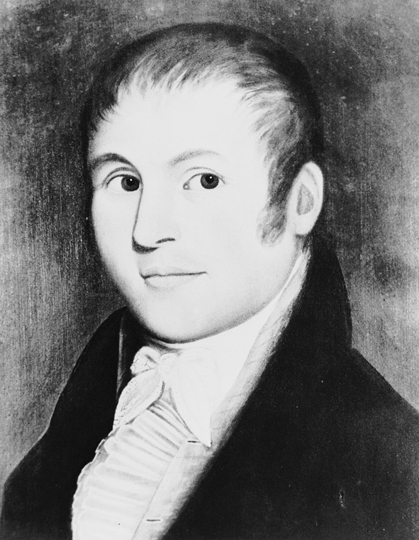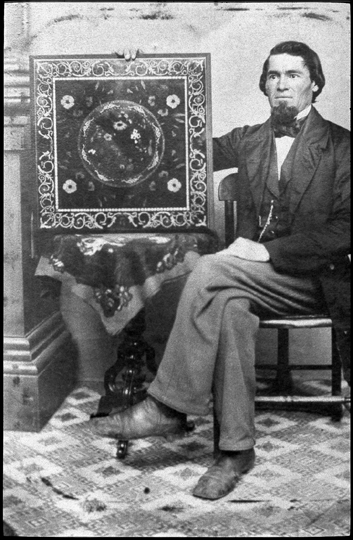



Nathan Lombard
(1777-1847)
Peter Glass
(1824-1901)
Silas Kopf
b. 1949
In the case
figure 67 Bedchamber (cubiculum
nocturnum), from the villa of P. Fannius Synistor, Pompeii, Boscoreale, Italy, €rst
century b.c.e. Fresco on lime plaster. H. 8' (average). (Courtesy, The Metropolitan Museum of Art. Rogers Fund, 1903 [03.14.13]; photo, © 1986 The Metropolitan Museum
of Art.) This image shows the east wall of
the room.
figure 125 Jupiter, England, ca. 1815. Earthenware and polychrome decoration. (Private collection.)
figure 126 Diana, England, 1790–1800. Earthenware, polychrome decoration, and copper wire. (Private collection.)
figure 68 Vase, England, 1790–1800. Earthenware and enameled decoration. H. 8˛÷¢". (Courtesy, Elbert H. Parsons, Jr.; photo, Gavin Ashworth.)
On platform, from left to right
Fancy Armchair, 1810–20
New York or New England
Painted wood, probably birch or maple
Lent by the Museum of Fine Arts, Boston, Gift of David Stockman and H. E. Bolles Fund
Fancy Chair, ca. 1800
Attributed to John and Thomas Seymour
(American, born England 1738–1818;
American, born England 1771–1848)
Boston, Massachusetts
Painted birch
Lent by the Peabody Essex Museum, Salem, Massachusetts
Fancy Chair, 1805–15
Design attributed to Benjamin Henry Latrobe
(American, born England 1764–1820)
Built by Thomas Wetherill, possibly painted
by George Bridport
Philadelphia, Pennsylvania
Gessoed, painted and gilded tulip and maple with caned seat
Lent by the Chipstone Foundation
Card Table, ca. 1815
Attributed to Hugh and John Finlay (American, active 1799–1840)
Baltimore, Maryland
Painted mahogany, poplar, and other woods
Lent by Mrs. George M. Kaufman
Above Window
Cornice, 1828
Hugh Finlay (American, active 1799–1840)
Baltimore, Maryland
Painted tulip poplar
Lent by a private collectionOn platform,
from left to right
Side Chair, 1815
John and Hugh Finlay (American, active 1799–1840)
Baltimore, Maryland
Painted poplar, maple, and walnut
Lent by the Maryland Historical Society
Fancy Settee, 1805–20
Attributed to Hugh and John Finlay (American, active 1799–1840)
Baltimore, Maryland
Painted maple, walnut, and poplar
Lent by the Maryland Historical Society
Card Table, ca. 1810
Baltimore, Maryland
Mahogany veneer, painted tulip wood, white pine and poplar
Lent by Winterthur Museum, Bequest of Henry Francis du Pont
Card Table, 1795–1810
New York, New York
Painted maple and white pine
Lent by Winterthur Museum, Gift of Henry Francis du Pont.
Text panel:
FANCY FURNITURE
Excavations at Herculaneum and Pompeii had an astounding impact on neo-classic style in the third quarter of the eighteenth century. The domestic structures uncovered there were covered from one end to the other with brilliant colors and enchanting frescoes. These interiors totally altered the eighteenth century conception of the classical "ideal". Not only delicacy, but sensuality and delight, had permeated the ancient world.
By their very nature, Herculaneum and Pompeii provided a tangible new model for the sense of balance between reason and imagination. They furnished to eighteenth century society a stylistic prototype which justified its fanciful taste. "Fancy furniture" served as an important expression of this new understanding.Illustration:
Domestic Interior from Herculaneum. A.D. 79.Objects:
1. FANCY SETTEE. Baltimore, Maryland. l805-20. Attributed to Hugh and John Finlay. Painted Maple, walnut and poplar. Length 73 1/2". Maryland Historical Society. (Vermillion ground)
2. FANCY CHAIR. Salem. 1795-1800. Painted Wood. Height 38 5/8". Collection of Milwaukee Art Museum. (White ground)
This chair was originally owned by the Derby Family of Salem, Massachusetts, and may be one of a set ordered from Joseph Anthony and Company of Philadelphia.
3. FANCY CHAIR. Attributed to John and Thomas Seymour, Boston. Circa l800. Height 36". Munson Williams Proctor Institute. 77.65.
(Black ground)
4. FANCY ARMCHAIR. New York or New England. Circa 1815. Painted wood. Height 34 5/8". Courtesy Museum of Fine Arts, Boston. l977.806.
5. SIDE CHAIR. Baltimore. l805-15. Painted Cherry and maple. Height 38 1/8". Courtesy the Henry Francis du Pont Winterthur Museum. 57.571.
6. PATENT FANCY CHAIR. Samuel Gragg. Boston. 1808-15. Painted birch, white oak, and beech. Height 34 3/8". Courtesy Milwaukee Art Museum. (Buff ground)
7. CARD TABLE (one of a pair). Baltimore. Circa l8l0. Painted Tulip Poplar, with white pine and poplar. Height 28 5/8" . Courtesy the H. F. du Pont Winterthur Museum. 57.1072.1. (red ground)
8. CORNER TABLE. Possibly by William Camp. Baltimore. 1800-1810. Mahogany with white pine, marble, and eglomise panels. Height: 36 1/2". Maryland Historical Society, 38.7.4. (mahogany)